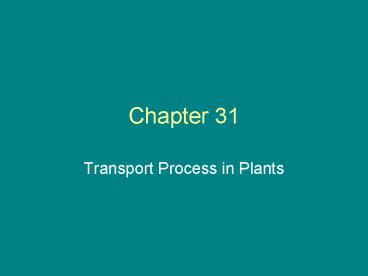Transport Process in Plants PowerPoint PPT Presentation
1 / 17
Title: Transport Process in Plants
1
Chapter 31
- Transport Process in Plants
2
The Movement of Water and Minerals
- Transpiration
- More than 90 percent of the water entering a
plants roots is released into the air as water
vapor. - This loss of water vapor from the plant body is
known as transpiration.
3
The Cohesion-Tension Theory
- Transpiration of a water molecule results in a
negative pressure in the leaf cells, inducing the
entrance from the vascular tissue of another
water molecule, which, because of the cohesive
property of water, pulls with it a chain of water
molecules extending up from the cells of the root
tip. - This process is powered by the energy of the sun,
not from the plant.
4
Factors Influencing Transpiration
- Temperature- the rate of evaporation doubles for
every 10C increase in temperature. - Humidity
- The regulatory effect exercised by the opening
and closing of the stomata.
5
The Mechanism of Stomatal Movements
- The osmotic movement of water is involved in the
opening and closing of the stomata. - Each stoma has two surrounding guard cells.
- When the guard cells are turgid, they blow out,
opening the stoma. When they lose water, they
relax and the stoma closes.
6
The Uptake of Minerals
- Plant cells require a number of different
chemical elements, which are found in the earth
in the form of minerals. - A mineral is a naturally occurring inorganic
substance, usually solid, with a definite
chemical composition. - Mineral ions are taken up in the water solution
by the roots and travel through the xylem in the
transpiration stream . - Minerals ions are brought into plant cells by
active transport.
7
Mineral Requirement of Plants
- Plants require minerals for a number of
functions. (the most critical is the regulation
of water balance) - Specific elements may be an essential component
of a critical biological molecule which will not
function properly in its absence - Non Specific elements are those that have
interchangeable roles. - Some minerals, phosphorus and calcium, are
required constituents of cell membranes and
membrane permeability.
8
- Other minerals are indispensable components of a
variety of enzyme systems that catalyze chemical
reactions in the cell
9
The Movement of Sugars Translocation
- The process by which the product of
photosynthesis are transported to other tissues
is known as translocation.
10
Evidence for the Phloem
- 300 years ago botanists recognized that water is
transported in the tracheids and vessels of the
xylem. - There was debates about the role of the phloem in
the movement of sugar.
11
The Pressure Flow Hypothesis
- The movement of sugars and other organic solutes
in translocation follows what is known as a
source-to-sink pattern. - The most widely accepted explanation for this is
the pressure-flow hypothesis. - The pressure-flow hypothesis states that the
solutes move in solutions that move because of
differences in water potential caused by
concentration gradients of sugar.
12
Model of the Pressure-Flow Hypothesis
13
Factors Influencing Plant Nutrition
- Soil Composition
- Soil is composed of rock fragments associated
with organic material , both living and in
various stages of decomposition. - The mineral content of soil depends in part on
the parent rock from which the soil was formed. - Mineral contents is more dependant on biological
factor - The size of the soil particles are another
factor. The larger the particles, the faster
water and minerals drain through the soil.
14
- Under natural conditions, the soil and the
availability of nutrients and water to plant
roots, are constantly changing. - This is because plants secrete hydrogen ions,
which help to degrade rock surfaces and release
positively charged ions form those surfaces. - As they decay, plant parts constantly add to the
humus, changing the content of the soil, its
texture, and its capacity to hold minerals and
water. - In return, plants are dependant upon the mineral
content of the soil and its holding capacity. As
theses improve, plants increase in both number
and size and sometimes change in kind. This
produces changes in the soil.
15
The Role of Symbiosis
- Mycorrhizae- the association between fungi and
roots. The fungi extract nutrients form the soil
and make them available to plants. - Plans have the greatest requirement for nitrogen
but because they cannot use gaseous nitrogen,
plants are dependant upon nitrogen containing
ions, ammonium and nitrate ,from the soil. - The nitrogen-containing compounds are returned to
the soil by the death of the plant and are
reprocessed by soil organisms, taken up by plant
roots in the form of nitrate dissolved in water
and reconverted to organic compounds.
16
- The lost nitrogen is returned to the soil by
nitrogen fixation, the process by which
atmospheric nitrogen is incorporated into organic
nitrogen-containing compounds. - The symbiotic bacteria are by far the most
important in terms of total amounts of nitrogen
fixed. - The most common of the nitrogen fixing symbiotic
bacteria is Rhizobium.
17
Recombinant DNA and Nitrogen Fixing
- Genetic mapping of a free-living nitrogen-fixing
bacterium has shown that the 17 genes known to be
involved in nitrogen fixation are clustered on
one portion of the chromosome. - Experiments have tried to show that nitrogen
fixing genes can be transferred to the cells of
plants such as corn, which could then, in effect,
make their own nitrogen-containing-compounds. - Such experiments have not worked out yet but show
great potential in the near future.

